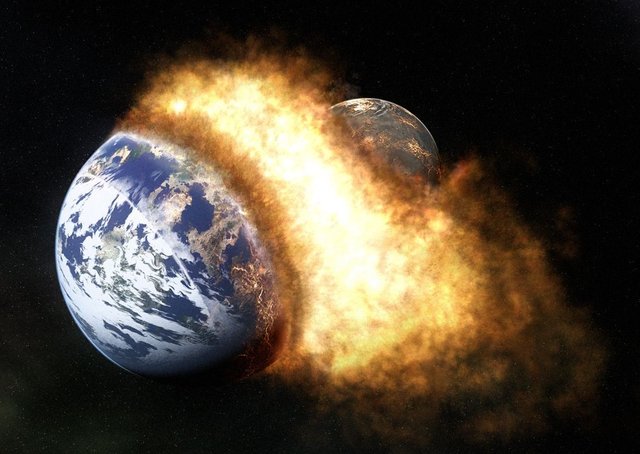Researchers: Collision Between Earth And Ancient Planet Sparked First Forms Of Life 4 Billion Years Ago

Scientists in Britain are claiming life on our planet evolved shortly after a Mars-size object called Theia violently collided with Earth approximately 150 million years after the solar system was formed (4.45 billion years ago).
The catastrophic impact resulted in a massive debris cloud composed of material from both Earth and Theia. After a period of “sterilization,” the remnants of the rogue planet eventually reformed into a near-perfect, yet much smaller, sphere and proceeded to orbit Earth as the Moon.
Interestingly enough, the colliding body was named after a Mythical Greek Titan whose daughter, Selene, was the “Goddess of the Moon.”
In a newly published study on Nature.com titled Integrated genomic and fossil evidence illuminates life’s early evolution and eukaryote origin, authors Holly C. Betts, Mark N. Puttick and others revealed the complications experts have faced while trying to pinpoint the exact moment in time when life occurred as well as the methods they used to capture this world-changing revelation:
“Attempts to investigate the emergence of life and its subsequent evolution have traditionally focused on the fossil record. However, this record, especially when looking at the earliest scions of life, is minimal and interpretation is made harder due to difficulties substantiating relationships within the earliest branch-ing lineages of the tree of life. Despite its problematic nature, the fossil record remains the main source of information for the time-line of life’s evolution.”
“We attempt to shed light on this early period by presenting a molecular timescale based on the ever-growing collection of genetic data, and explicitly incorporating uncertainty associated with fossil sampling, ages and interpretations.”
Although this new methodology for determining the beginning of life and earliest known common ancestors among Earth’s organisms seems promising, Betts admits it is not immune to inaccuracies. In a Daily Mail op-ed, she writes:
“Our results – a timescale for the origin and evolution of life – do come with fairly large uncertainties on the age estimates for each of the nodes, the places on the [family] tree where species have a common ancestor.”
“This is especially true for the most ancient parts of the tree and those parts where we have the least data, either fossil or molecular.”
Betts continues by stating she remains hopeful because the timescale her team has used is “not over-confident by showing precise, but false, ages.” It, in fact, leaves room for additional data as it is discovered, hence resulting in a higher degree of precision in the future.
Read the Nature Ecology & Evolution article here.
Main Image Credit: DeviantArt (rufohg)